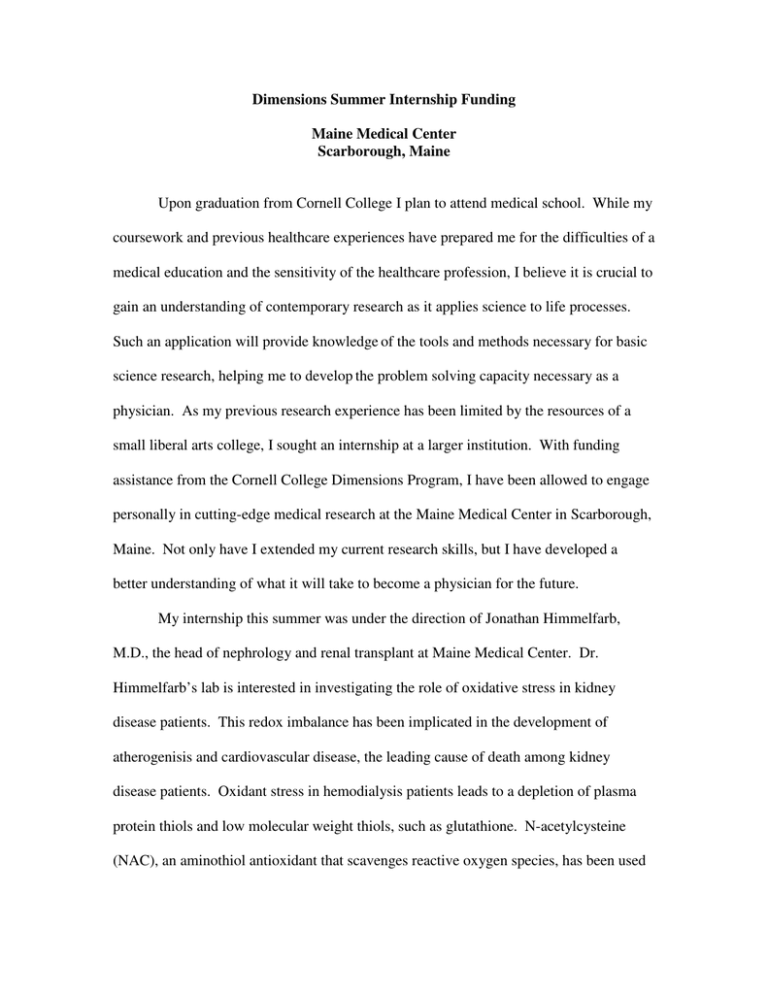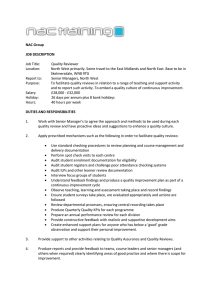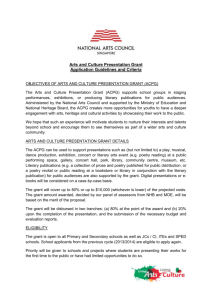Dimensions Summer Internship Funding Maine Medical Center Scarborough, Maine
advertisement

Dimensions Summer Internship Funding Maine Medical Center Scarborough, Maine Upon graduation from Cornell College I plan to attend medical school. While my coursework and previous healthcare experiences have prepared me for the difficulties of a medical education and the sensitivity of the healthcare profession, I believe it is crucial to gain an understanding of contemporary research as it applies science to life processes. Such an application will provide knowledge of the tools and methods necessary for basic science research, helping me to develop the problem solving capacity necessary as a physician. As my previous research experience has been limited by the resources of a small liberal arts college, I sought an internship at a larger institution. With funding assistance from the Cornell College Dimensions Program, I have been allowed to engage personally in cutting-edge medical research at the Maine Medical Center in Scarborough, Maine. Not only have I extended my current research skills, but I have developed a better understanding of what it will take to become a physician for the future. My internship this summer was under the direction of Jonathan Himmelfarb, M.D., the head of nephrology and renal transplant at Maine Medical Center. Dr. Himmelfarb’s lab is interested in investigating the role of oxidative stress in kidney disease patients. This redox imbalance has been implicated in the development of atherogenisis and cardiovascular disease, the leading cause of death among kidney disease patients. Oxidant stress in hemodialysis patients leads to a depletion of plasma protein thiols and low molecular weight thiols, such as glutathione. N-acetylcysteine (NAC), an aminothiol antioxidant that scavenges reactive oxygen species, has been used clincally as a source of cyteine for glutathione sytnthesis. The pharmacokenetics and pharmacodynamics of NAC have been studied in patients without kidney disease; however, such studies have not been done to determine the proper dosing of NAC in hemodialysis patients. In order to establish the pharmacokentetics of NAC, a method must to be developed to determine NAC concentration in human plasma. Therefore, my study was conducted to determine NAC in hemodialysis patients using high performance liquid chromatography (HPLC). Initially, twelve hemodialysis patients were given randomized doses of NAC (600 and 1200 mg) twice daily by mouth for 14 days. On day 15, blood was collected at various time points for eight hours. I then centrifuged the blood to remove the plasma and processed the samples to run on HPLC. My project was mainly concerned with developing the HPLC conditions that would create the best peaks for NAC, showing clear separation of the NAC analyte from the other blood solutes. To do this, blood from patients was collected in tubes containing EDTA as an anticoagulant. The blood was centrifuged and plasma (500 uL) was treated with 5 uL of a 100 mM aqueous solution of DTPA (removing iron), 50 uL of a 10 mM aqueous solution of sodium nitrite (derivatization for UV analysis) followed by 50 uL fo a 50 wt% solution of 5sulfosalicylic acid (remove protein) and 50 uL of 6N HCl. The suspensions were centrifuged to remove the containments (1500g, 5 min) at 2ºC, and 200 uL aliquots of the supernatants were injected into the HPLC system. Reverse-Phase HPLC was performed using a Waters 626 pump and Waters 717 plus autosampler. The system was connected with a UV/visible Waters 2487 Dual Absorbance detector and a Waters 600S controller. Empower pro software was used to run the HPLC. The analytical column (250 X 4.6 mm) was packed with C18. The mobile phase was a mixture of acetonitrile and ammonia-formic acid (7/12 mM) buffer at pH 3.0 (12:88, v/v). The flow rate was 1.8 mL/min. The sample injection volume was 50 uL and the effluent was monitored at 333 nm. A standard curve was created to using stock solutions of NAC at concentrations of 0, 0.05, 0.2, 1, 5 and 20 ug/mL, however, linear regression analysis has yet to be performed because the HPLC conditions set forth were not quite sensitive enough to detect the lower concentrations of NAC seen in the blood. Below, my final chromatograph presents peaks depicting concentrations of NAC and MPG (an internal standard) in vitro. The second graph depicts the attempted standard curve at physiological levels; however, you can see that only the two highest concentrations of the analyte produce noticeable peaks. Thus, we cannot use this curve for in vivo detection. 0.0014 MPG 0.0012 AU 0.0010 0.0008 NAC 0.0006 0.0004 0.0002 0.0000 0.50 1.00 1.50 2.00 2.50 3.00 3.50 4.00 4.50 5.00 Minutes 5.50 6.00 6.50 7.00 7.50 8.00 8.50 9.00 9.50 0.006 0.005 0.004 AU NAC 20 ug/ mL 0.003 0.002 MPG 5 ug/ mL 0.001 0.000 4.00 4.20 4.40 4.60 4.80 5.00 5.20 5.40 5.60 5.80 6.00 6.20 6.40 6.60 Minutes 6.80 7.00 7.20 7.40 7.60 7.80 8.00 8.20 8.40 8.60 This summer, I was able to formulate the initial conditions for the NAC assay. This was used to successfully determine NAC in standard concentrations. However, the conditions were not sensitive enough to determine the standard curve. This could be because the plasma aliquot was too small or the injection volume was too small. To address this issue, mobile phase and other HPLC conditions will be manipulated along with volumes. I also assisted in the processing of blood samples taken from patients, preparing them future analysis. The next step will be to confirm the sensitivity of the assay in these plasma samples and to run a full validation QC. In conjunction with the research project, I shadowed physicians on teaching rounds and attended lectures presented by distinguished guest scientists and faculty. This comprehensive experience has given me a realistic understanding of the relationship between research, medicine, and patient care. Furthermore, it has helped me to develop empirical skills that I can utilize as a future physician. Interacting with patients in a clinical research setting, I have learned about the satisfaction that accompanies medical exploration and healing. As I have assisted in the discovery of novel information, my 8.80 9.00 passion for medicine has grown rapidly. I accepted this research position to put into practice the biological coursework I enjoyed during college. I have been able to accomplish just that, and more. My internship had both laboratory and clinical research objectives, and provided a comprehensive understanding of translational medicine. Participating in a hands-on research experience at a renowned, state-of-the-art research facility has allowed me to take the next step in my academic training. Working alongside distinguished physicians and scientists, I came to appreciate the intellectual excitement that comes with discovering knowledge, as well as the fulfillment associated with helping others through medicine. This opportunity, made possible by the Dimensions Program, has served as the pinnacle of my undergraduate studies, affording direction, skill, motivation, and practicality as I pursue the advancement of my medical education. Thanks!

